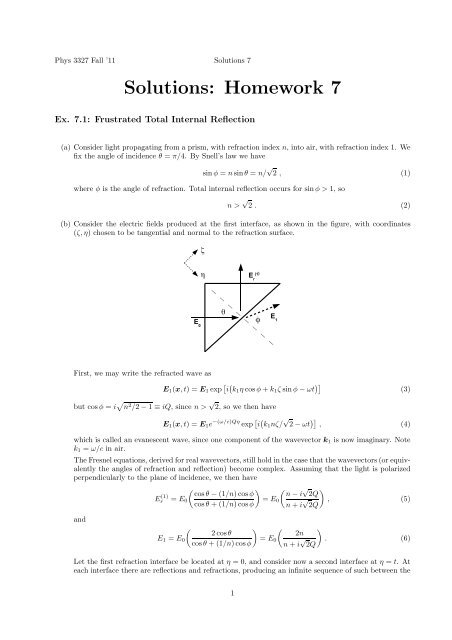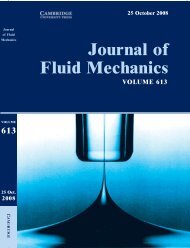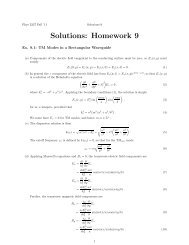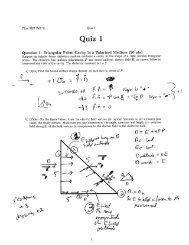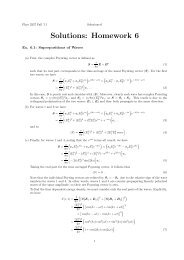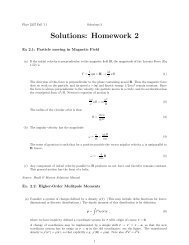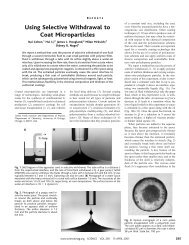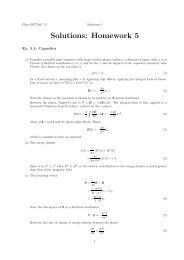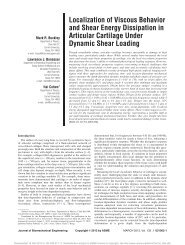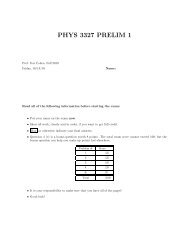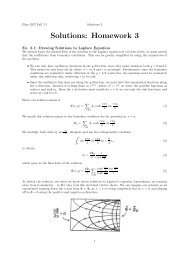HW7 solutions - Itai Cohen Group
HW7 solutions - Itai Cohen Group
HW7 solutions - Itai Cohen Group
You also want an ePaper? Increase the reach of your titles
YUMPU automatically turns print PDFs into web optimized ePapers that Google loves.
Phys 3327 Fall ’11 Solutions 7Solutions: Homework 7Ex. 7.1: Frustrated Total Internal Reflection(a) Consider light propagating from a prism, with refraction index n, into air, with refraction index 1. Wefix the angle of incidence θ = π/4. By Snell’s law we havesinφ = nsinθ = n/ √ 2 , (1)where φ is the angle of refraction. Total internal reflection occurs for sinφ > 1, son > √ 2 . (2)(b) Consider the electric fields produced at the first interface, as shown in the figure, with coordinates(ζ,η) chosen to be tangential and normal to the refraction surface.First, we may write the refracted wave asE 1 (x,t) = E 1 exp [ i ( k 1 ηcosφ+k 1 ζsinφ−ωt )] (3)but cosφ = i √ n 2 /2−1 ≡ iQ, since n > √ 2, so we then haveE 1 (x,t) = E 1 e −(ω/c)Qη exp [ i ( k 1 nζ/ √ 2−ωt )] , (4)which is called an evanescent wave, since one component of the wavevector k 1 is now imaginary. Notek 1 = ω/c in air.TheFresnelequations, derivedforrealwavevectors,still holdin the casethat the wavevectors(orequivalentlythe angles of refraction and reflection) become complex. Assuming that the light is polarizedperpendicularly to the plane of incidence, we then haveand( ) cosθ −(1/n)cosφE r (1) = E 0cosθ +(1/n)cosφ( √ ) n−i 2Q= E 0n+i √ , (5)2Q( ) ( )2cosθ 2nE 1 = E 0 = E 0cosθ+(1/n)cosφ n+i √ . (6)2QLet the first refraction interface be located at η = 0, and consider now a second interface at η = t. Ateach interface there are reflections and refractions, producing an infinite sequence of such between the1
Phys 3327 Fall ’11 Solutions 7and transmission back into a prism adds a factor( √ ) 2 2iQτ =n+i √ . (11)2QThe other factor( )2nκ =n+i √ 2Qarises precisely once, due to the original transmission into the air gap of the evanescent wave. Ingeneral, we may then write down the kth order reflected and transmitted waves asE (1)r = −E 0 ρE (k)r= E 0 e −(2k−2)(ω/c)Qt ρ 2k−3 κτ(12)E (k)t = E 0 e −(2k−1)(ω/c)Qt ρ 2k−2 κτ , (13)so we have two complex geometric series. Since |ρ| = 1, then these series are convergent, and soeE r = −ρE 0(1−κτ−2(ω/c)Qt )1−ρ 2 e −2(ω/c)Qte −(ω/c)QtE t = E 0 κτ(14)1−ρ 2 e −2(ω/c)Qtare the complex amplitudes of the reflected and transmitted waves.(c) Since E 0 , E r and E t all exist in the same medium, then the reflection and transmission coefficients aresimply∣ R =E r∣∣∣2∣E 0 ∣ T =E t∣∣∣2∣ . (15)E 0The algebra to determine R and T from eqs (14) can be done by Mathematica. One findsR =T =Note R+T = 1, as expected.(n 2 −1) 2( 1−e −2(ω/c)Qt) 2(1−e−2(ω/c)Qt ) 2+n2 (n 2 −2) ( 1+e −2(ω/c)Qt) 24(n 2 −2) 2 e −2(ω/c)Qt(1−e−2(ω/c)Qt ) 2+n2 (n 2 −2) ( 1+e −2(ω/c)Qt) 2(16)For t → 0, we have R = 0 and T = 1. This is precisely what is expected, since in the limit t → 0the air gap and the interfaces cease to exist, and so we expect the wave to propagate only forwards.Alternatively, in the limit t → ∞ we have R = 1 and T = 0, which is total internal reflection. Thistotal internal reflection is expected, since the limit t → ∞ corresponds to the lone prism of part (a).Alternative: For algebraic simplicity we can also consider eqs (14) in the limit n ≫ √ 2, in whichQ ≃ n/ √ 2. Then in this limitandκτ =4i(1+i) 2 = 2 , (17)ρ = − 1−i = −i . (18)1+i3
Phys 3327 Fall ’11 Solutions 7It follows immediately from (14) that( ) ( )|E r | = E 0 1−2 e−2(ω/c)Qt 1−e−2(ω/c)Qt= E1+e −2(ω/c)Qt 0 , (19)1+e −2(ω/c)Qt|E t | = 2E 0( e−(ω/c)Qt1+e −2(ω/c)Qt ). (20)Hence we have reflection and transmission coefficients, for n ≫ √ 2,∣ R =E r∣∣∣2 ( ) 1−e−2(ω/c)Qt 2∣ =E 0 1+e −2(ω/c)Qt ∣ T =E t∣∣∣24e −2(ω/c)Qt∣ =E 0 (1+e −2(ω/c)Qt ) . (21)2Ex. 7.2: Secondary RainbowConsider a light ray in air (n = 1) incident upon a spherical raindrop, such that it is internally reflectedtwice, as shown in the figure. Let the refractive index of the water be n, the angle of incidence θ and theangle of refraction β.Defining the total angle φ through which the light ray is refracted in the usual positive sense - i.e. counterclockwise- then we haveφ = (θ −β)+2(π−2β)+(θ −β)= 2θ−6β +2π= 2θ−6sin −1 ( 1n sinθ )+2π , (22)where the expression for β follows from Snell’s law. Note that we have defined the angle φ in the oppositesense to the angle of rotation for the primary rainbow.As we saw for the primary rainbow, the dominant emission of light occurs at φ min . Now,dφdθ = 2−and setting x = cosθ, then the minimum occurs where2−(6/n)cosθ√1−(1/n 2 )sin 2 θ(23)6x√n2 −(1−x 2 ) = 0 . (24)4
Phys 3327 Fall ’11 Solutions 7This is easily solved by squaring both sides, so thatand hencex 2 = n2 −18, (25)sinθ = √ 1−x 2 =√9−n28. (26)It follows that the minimum angle through which the light ray is rotated is then(√ ) ( √ )φ min = 2cos −1 n2 −1 1 9−n−6sin −1 2+2π . (27)8 n 8Note that by definition, θ and β lie in [0,π/2] so we may use sin −1 and cos −1 with the usual branch cuts.For water, n = 1.33, one then findsφ min = 230 ◦ . (28)If we define φ ′ min to be the clockwise conjugate angle to φ min, in order to match our definition for the primaryrainbow in class, thenφ ′ min ≡ 2π−φ min = 130 ◦ . (29)Now for water, the refractive index n = n(ω), where ω is the frequency of the incident radiation, anddn/dω > 0. By the chain ruledφ mindω = dφ min dndn dω , (30)and from (27) one can check that dφ min /dn > 0, so dφ min /dω > 0. Hence for larger ω, φ min is larger, andbecause φ is defined in a counterclockwise sense, then blue light will appear at the top of the rainbow, andred at the bottom. This is the opposite orientation to that of the primary rainbow, since φ min was definedin a clockwise sense for that case.Ex. 7.3: Brewster’s AngleConsider light propagating in a material n = n 1 incident at angle θ 1 upon the front surface of a dielectricslab with n = n 2 . Let the angle of refraction be θ 2 . Clearly θ 2 is the angle of incidence of the light ray onthe rear surface.If incidence on the front face occurs at the Brewster angle, thentanθ 1 = n 2n 1=⇒ sinθ 1 =By Snell’s law, the sine of the refraction angle θ 2n 2√n21 +n 2 2sinθ 2 = n 1 nsinθ 1 = √ 1n 2 n21 +n 2 2. (31), (32)so it follows that tanθ 2 = n 1 /n 2 . Hence incidence at the rear surface also occurs at the Brewster angle.5


